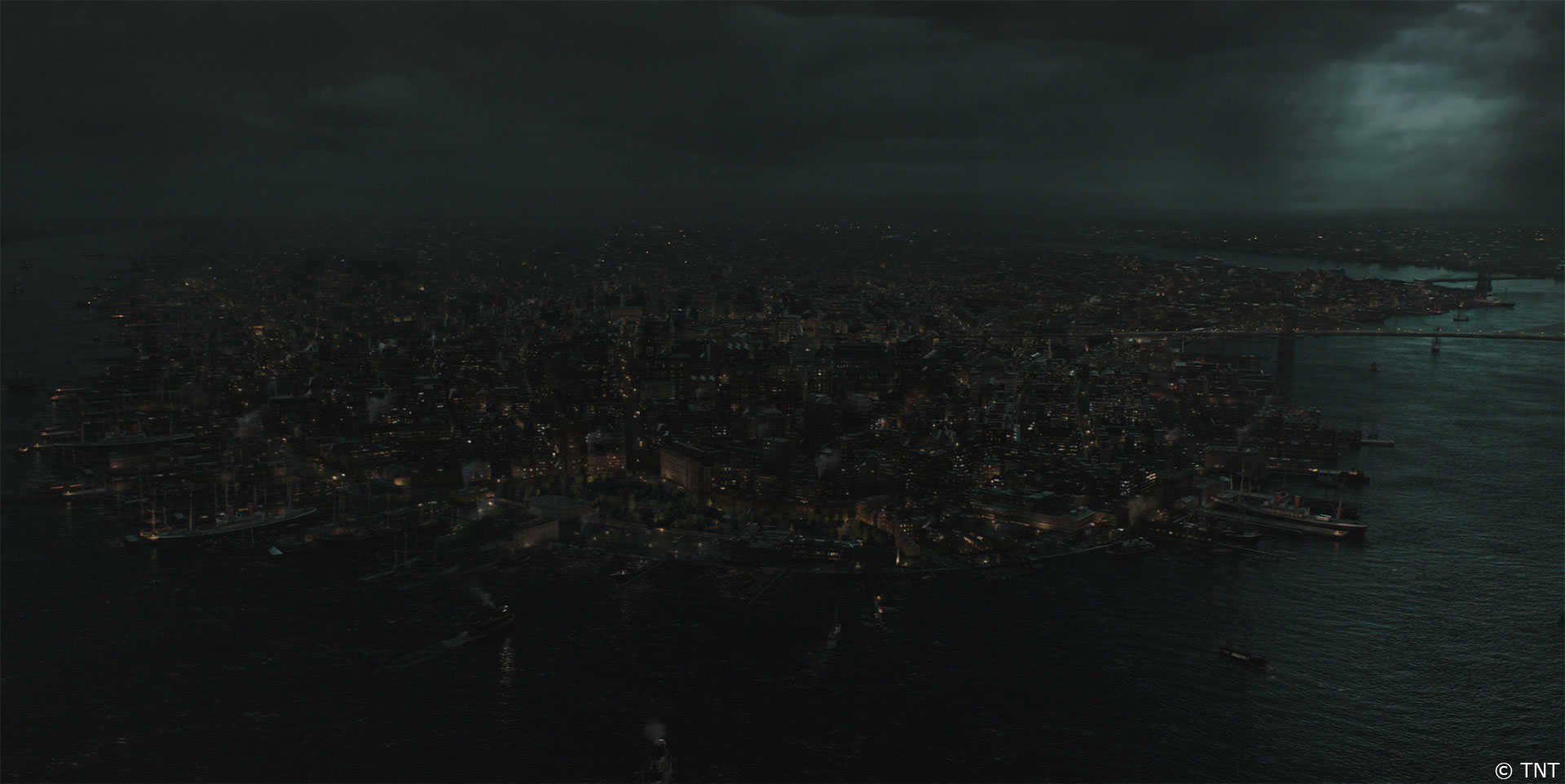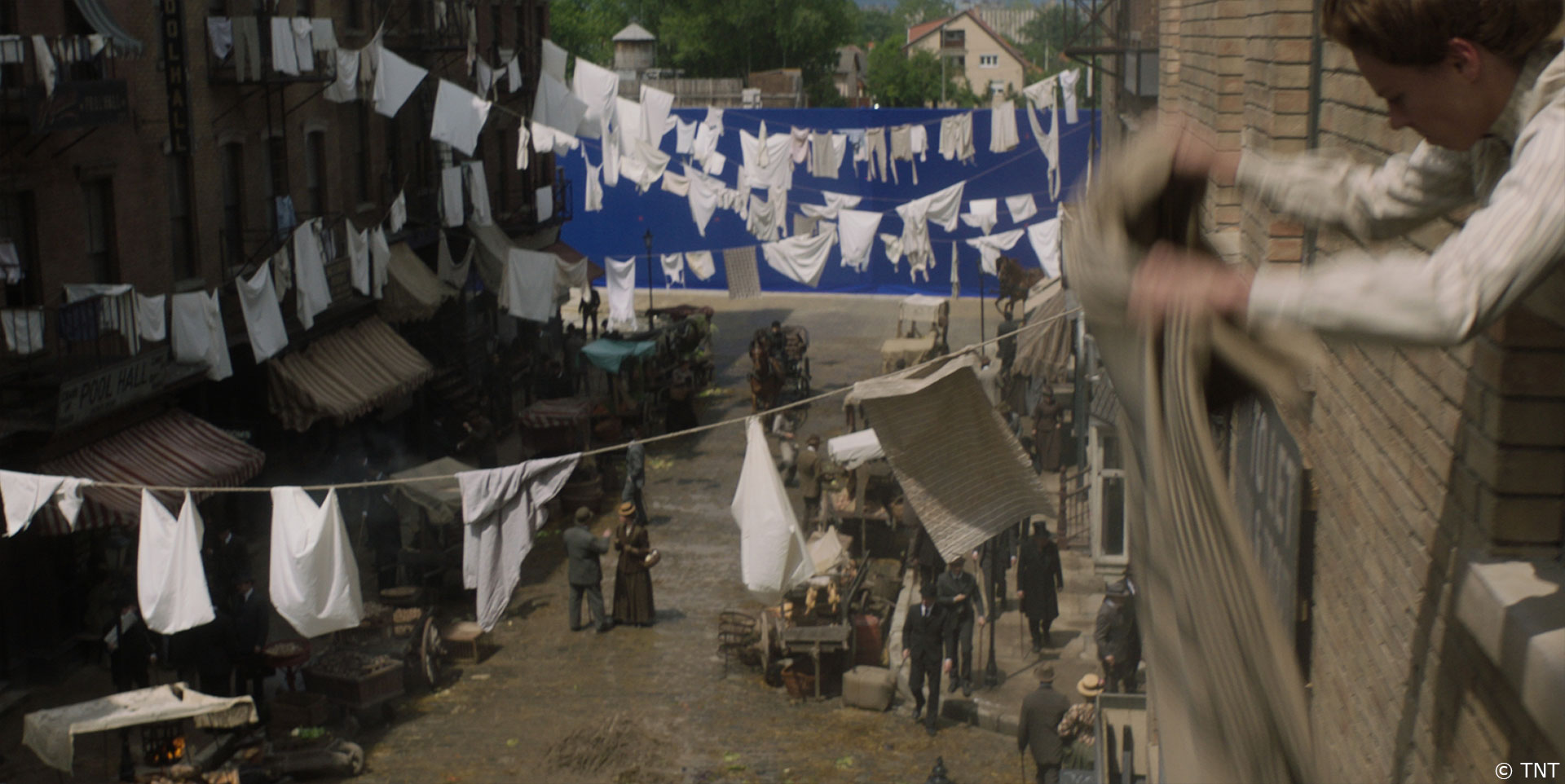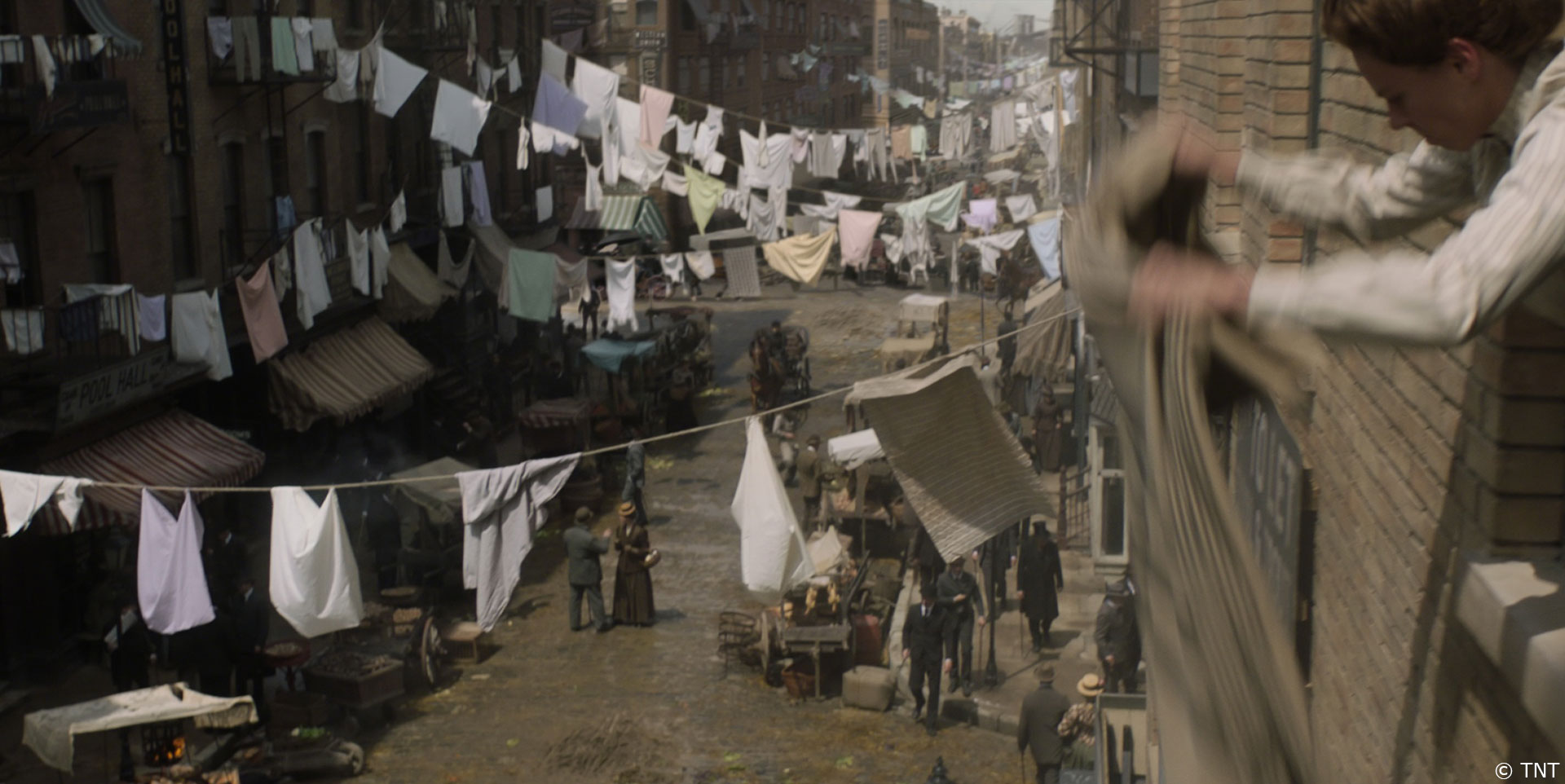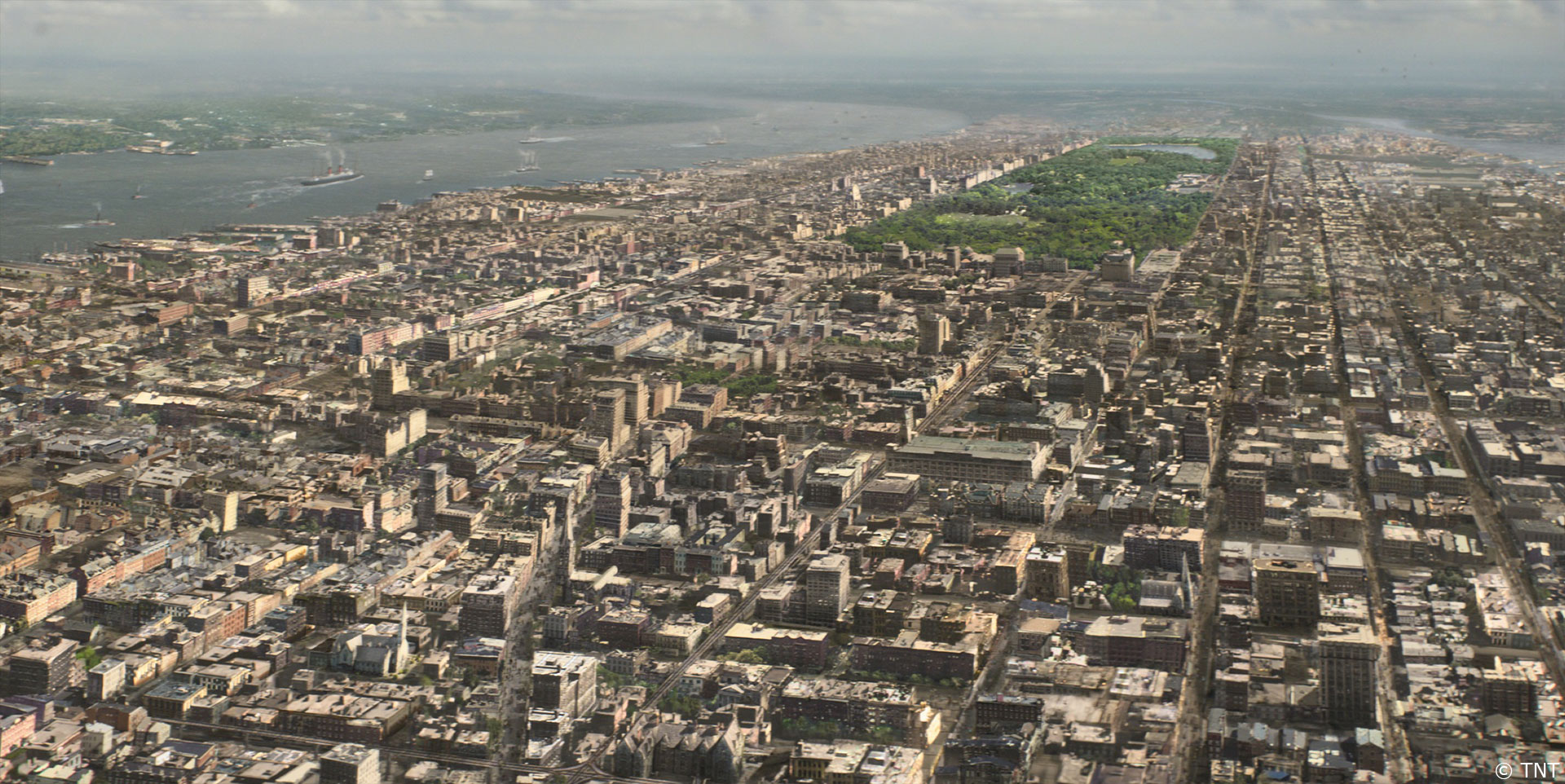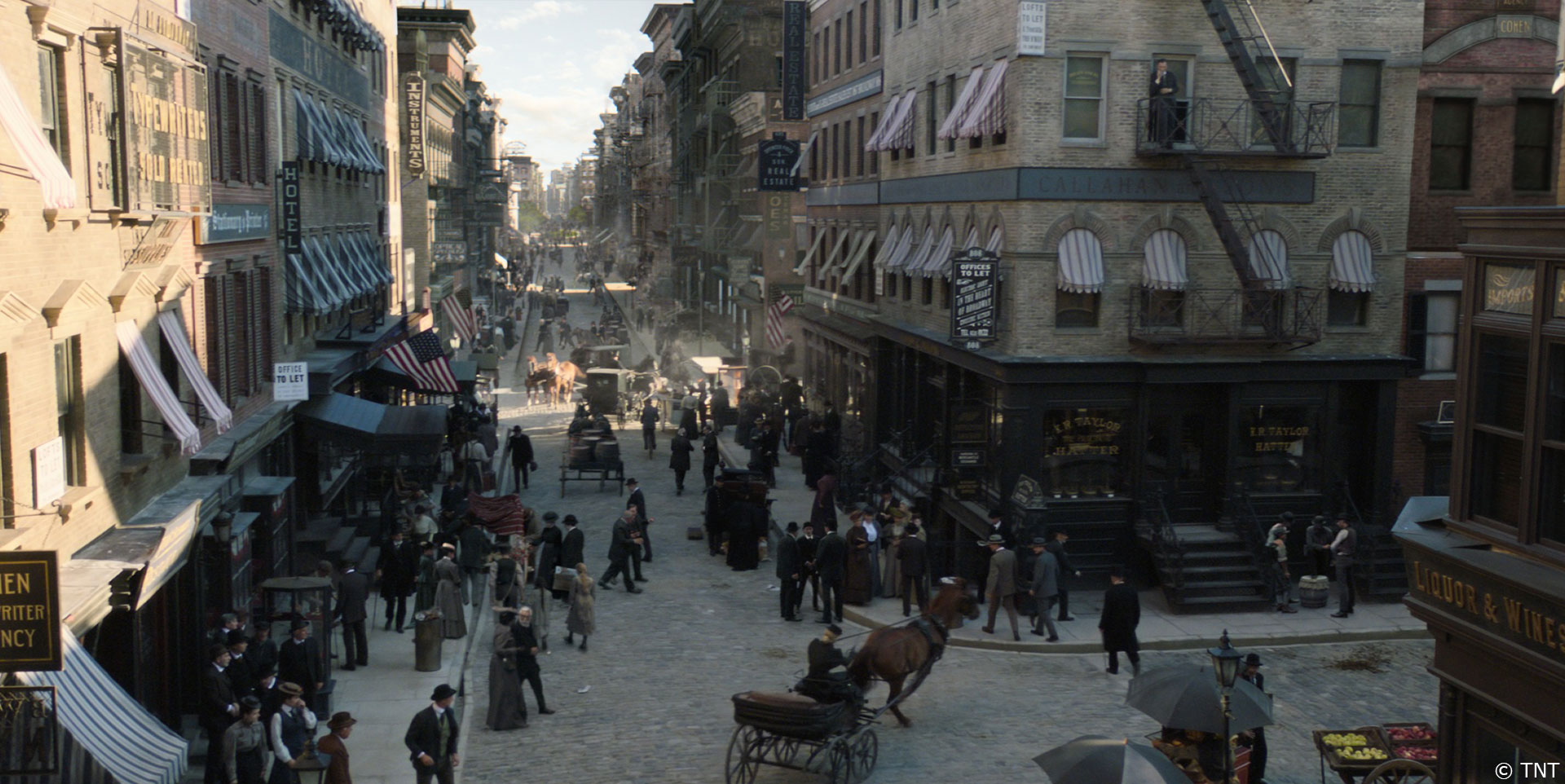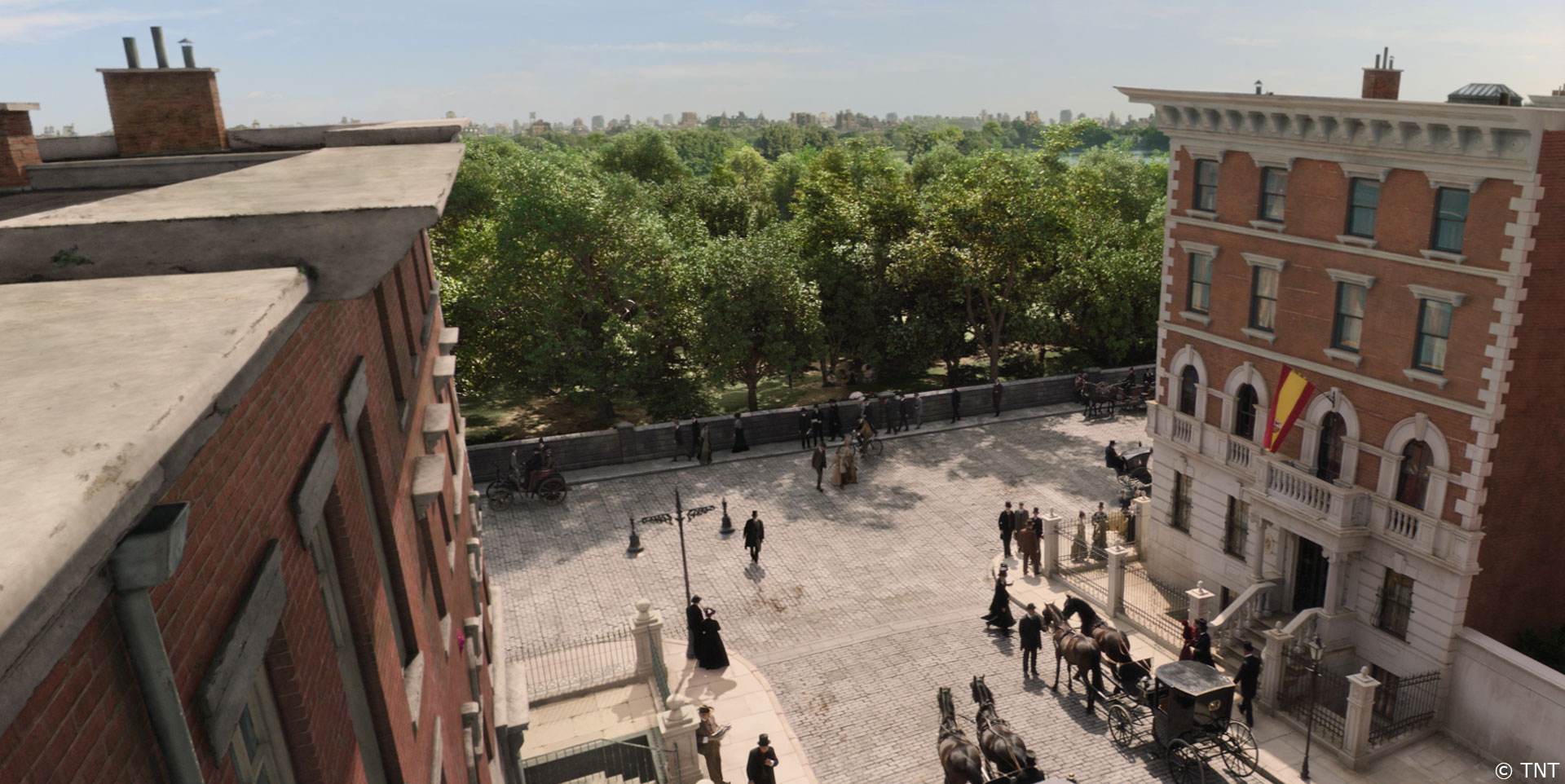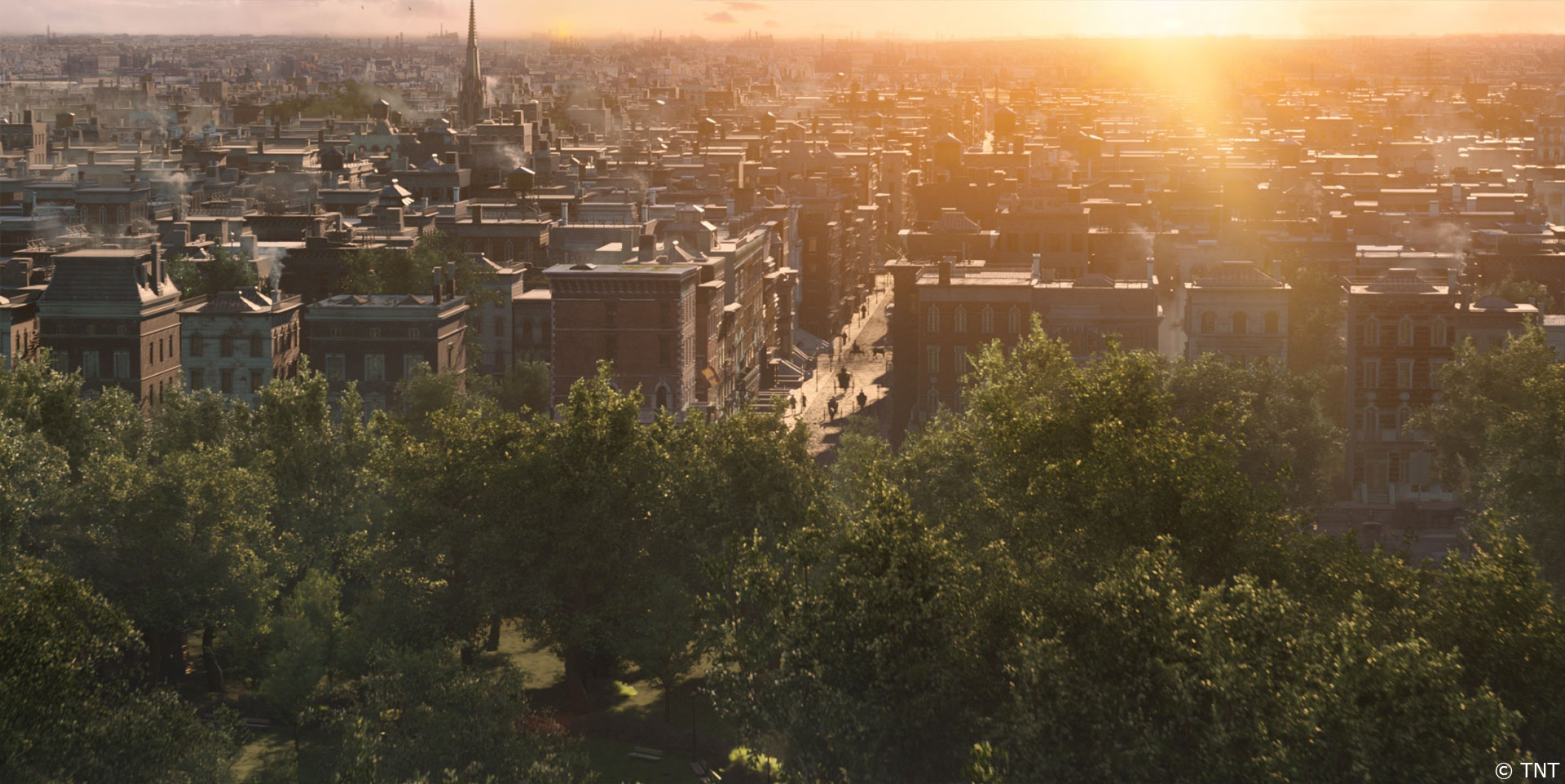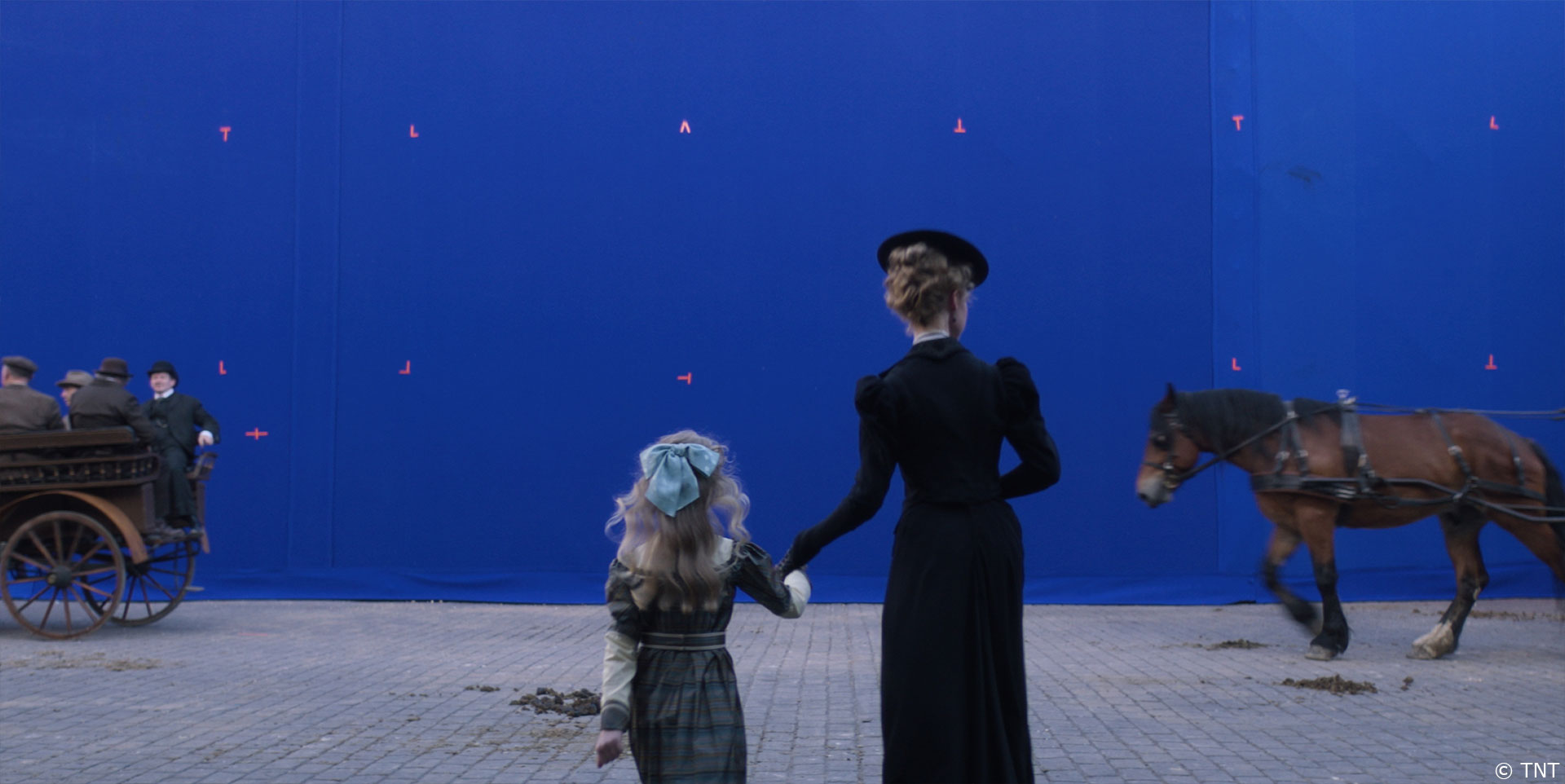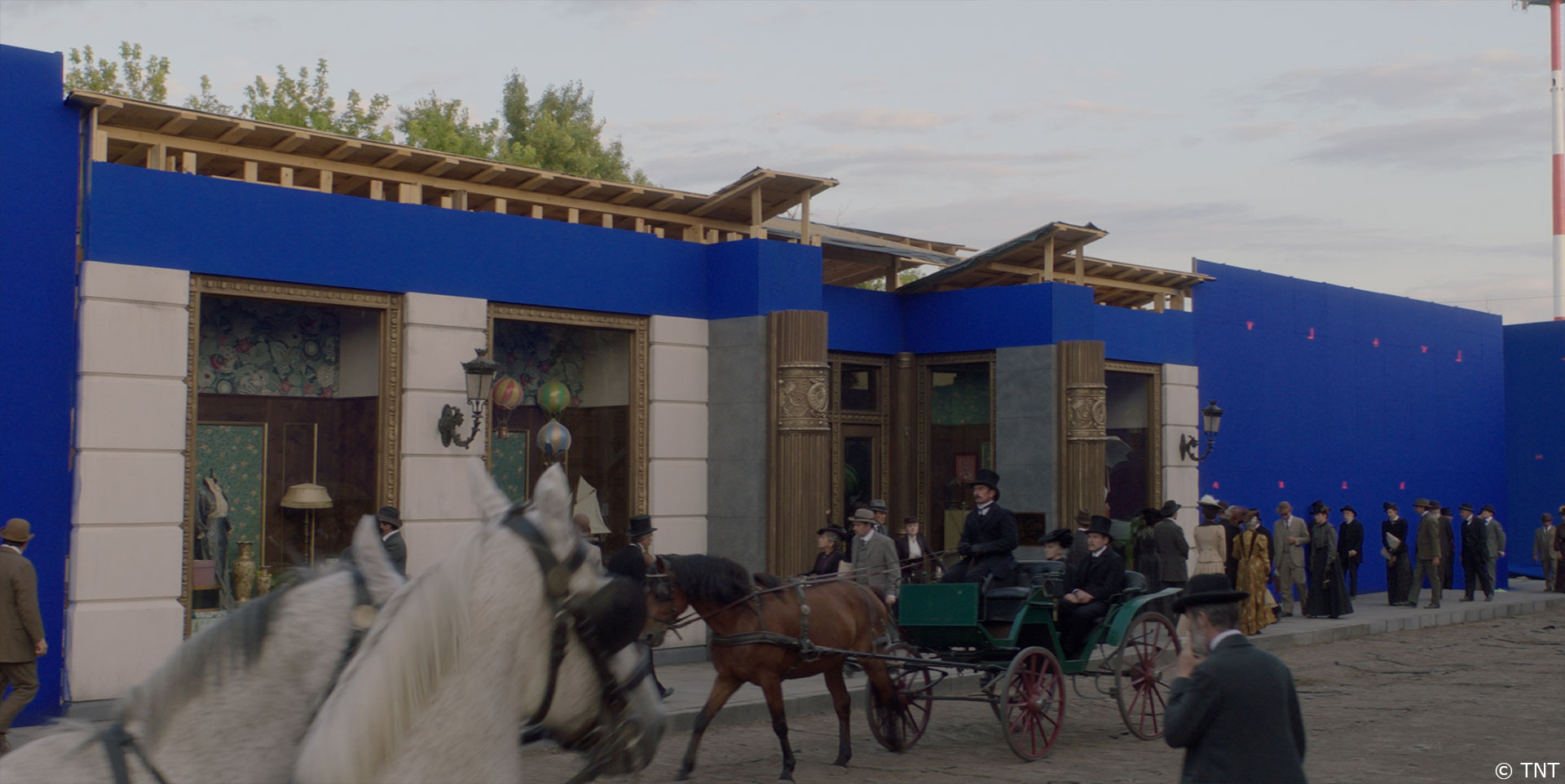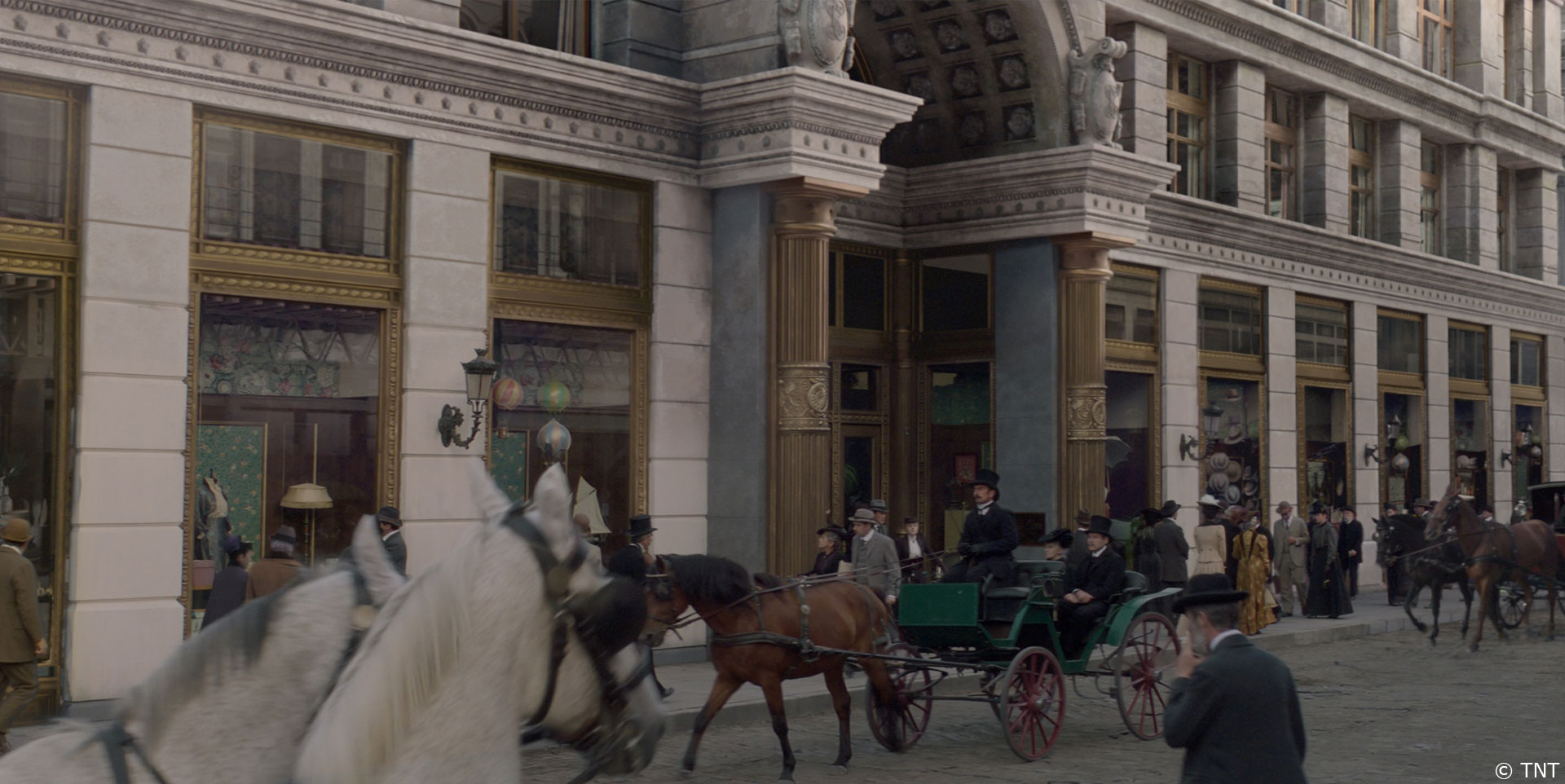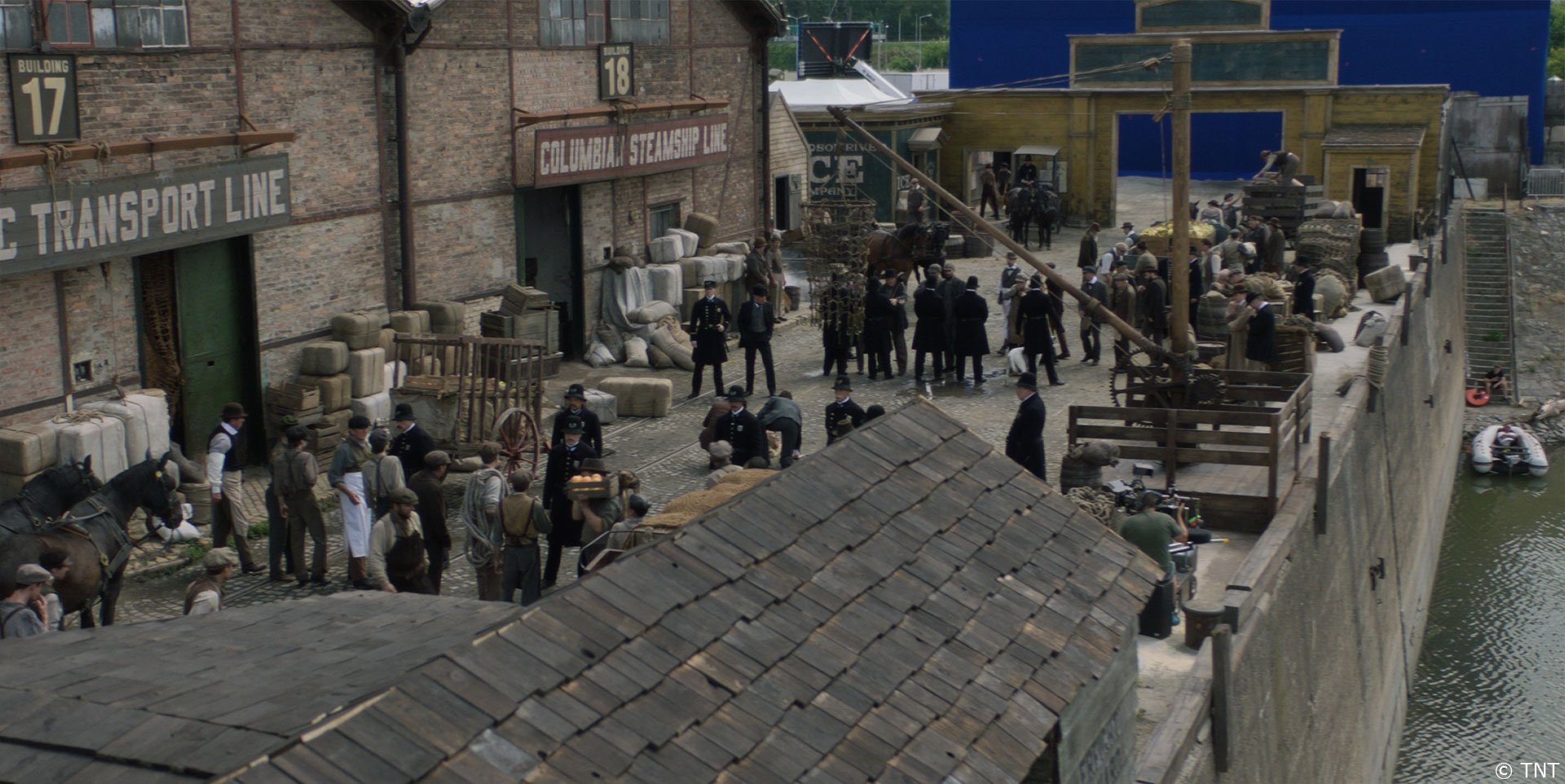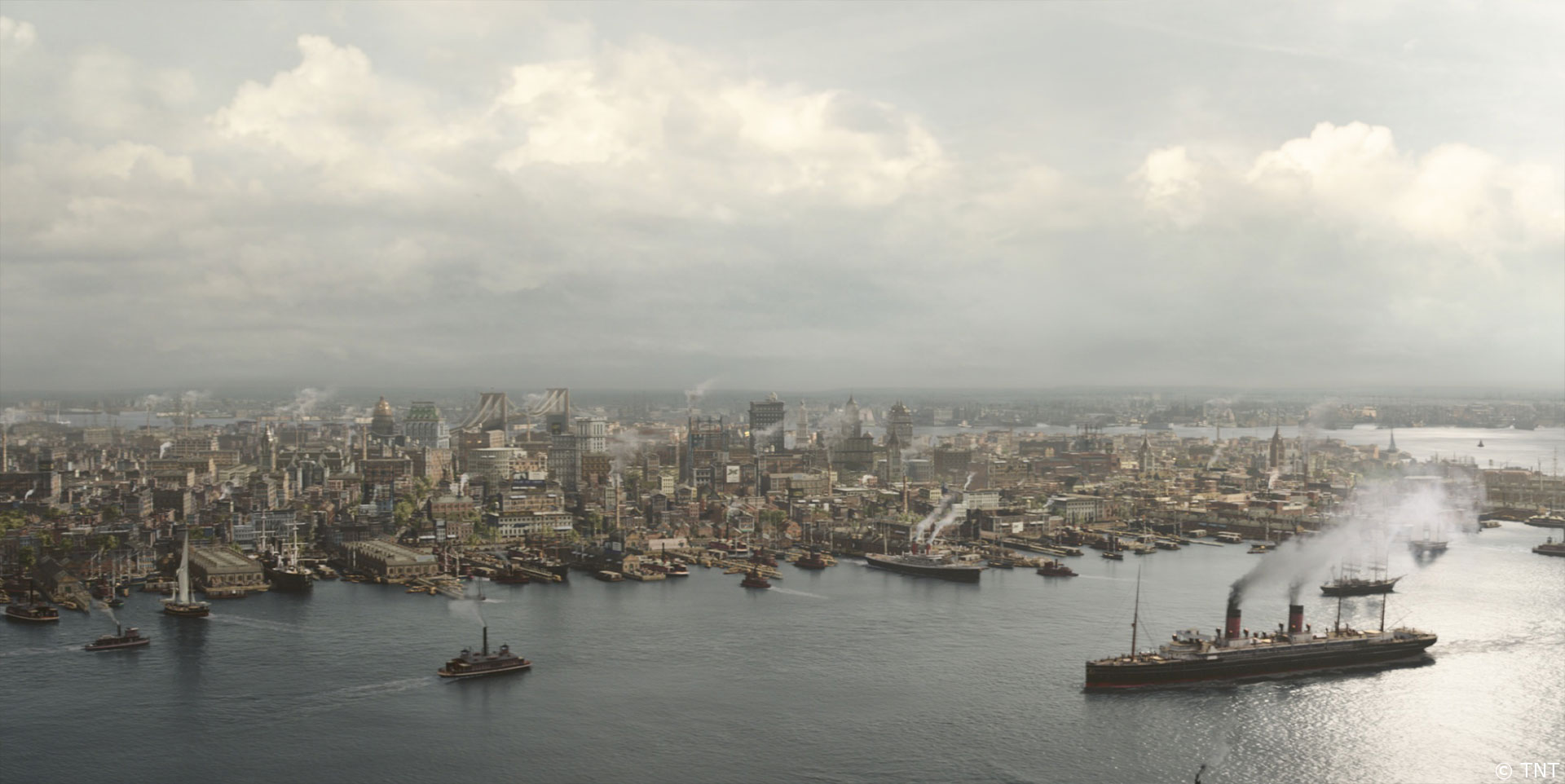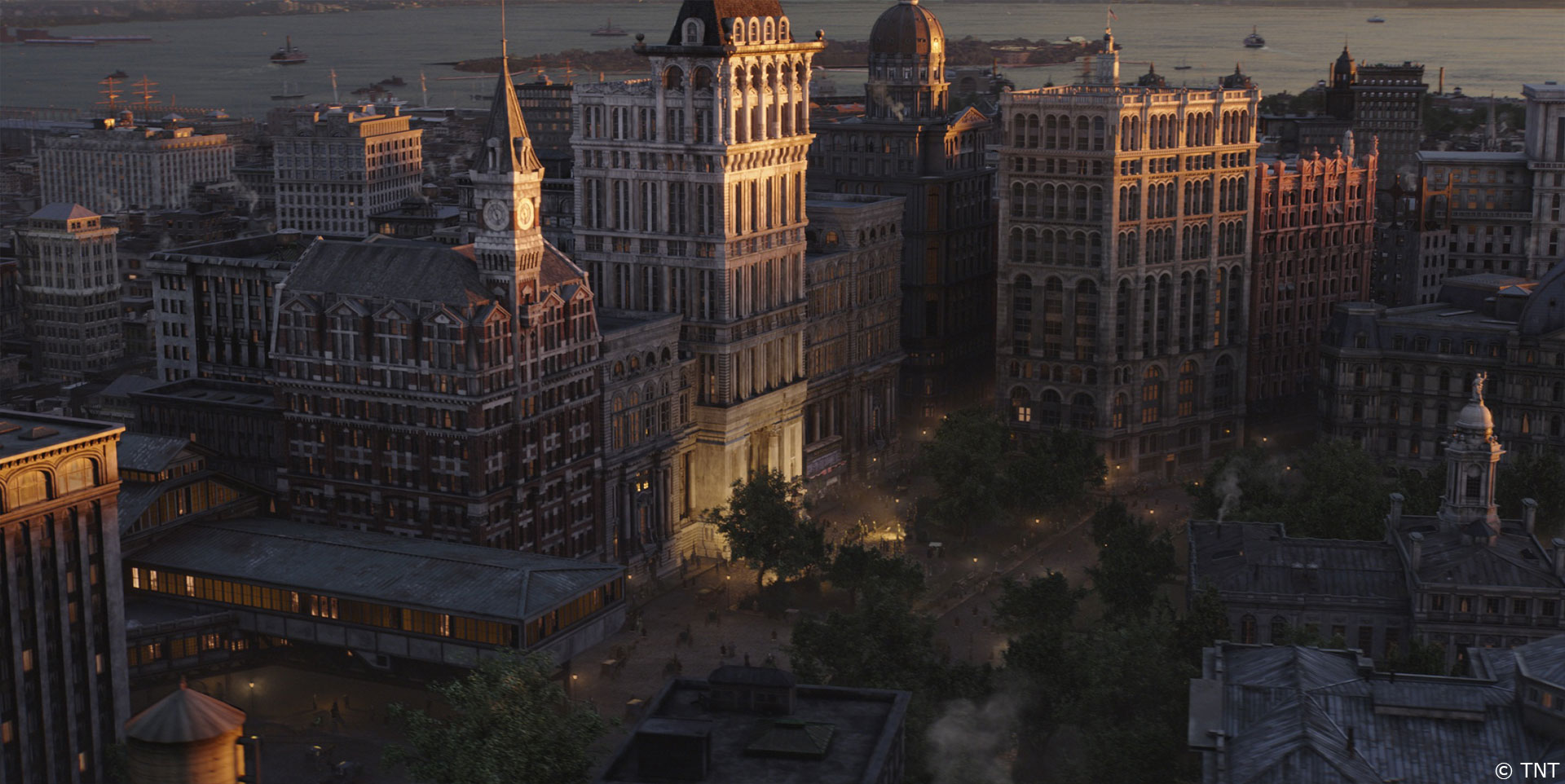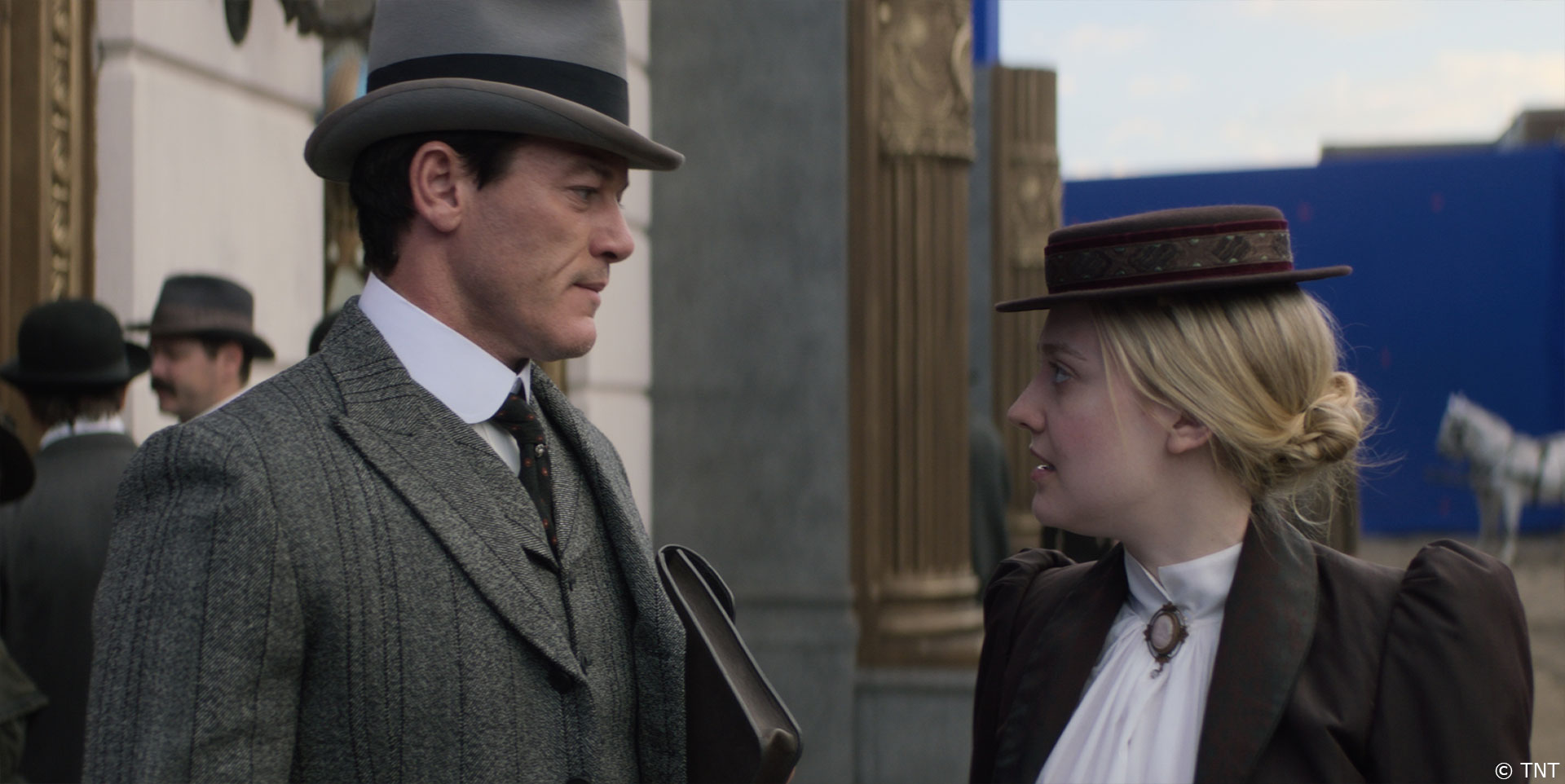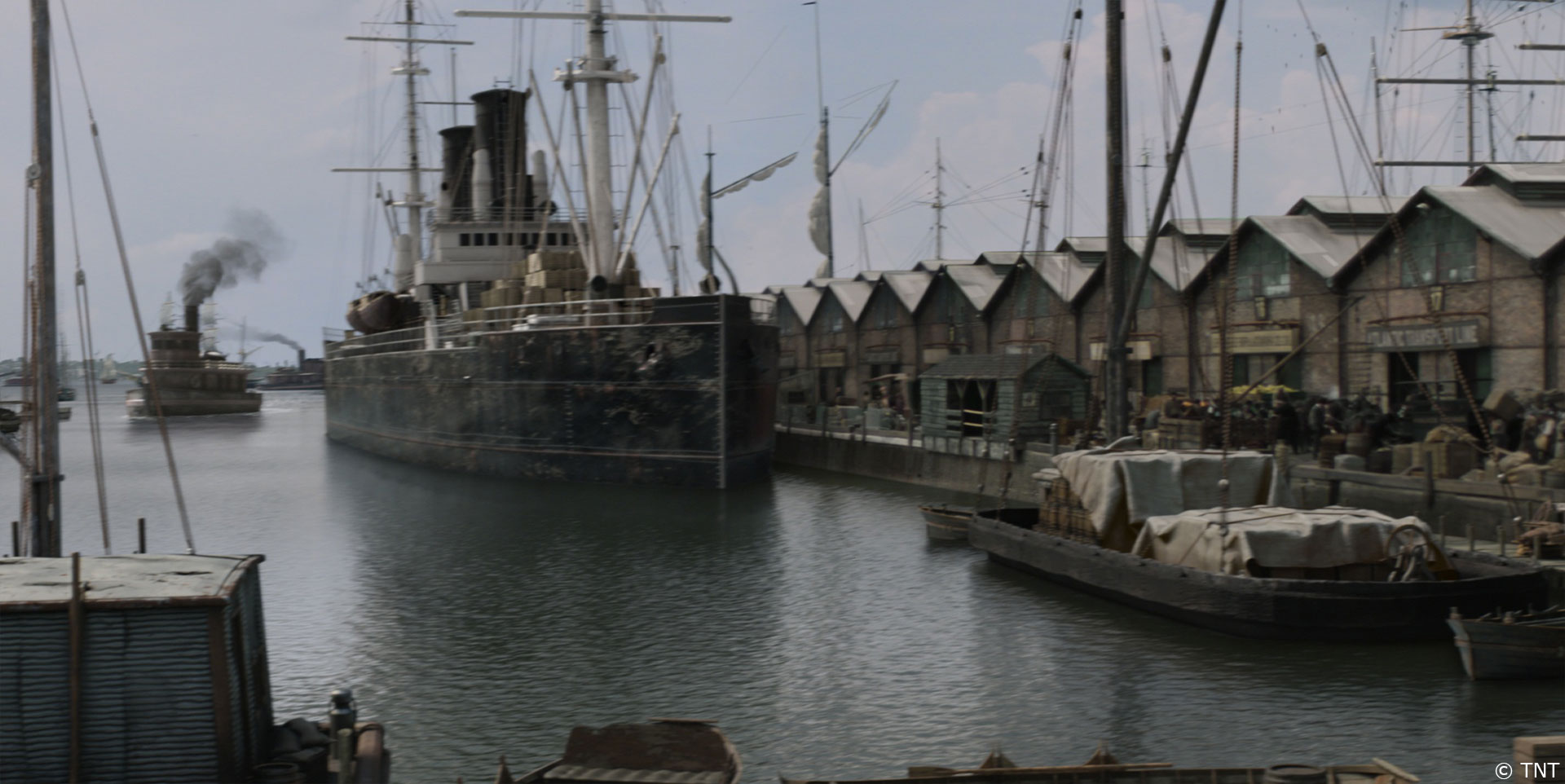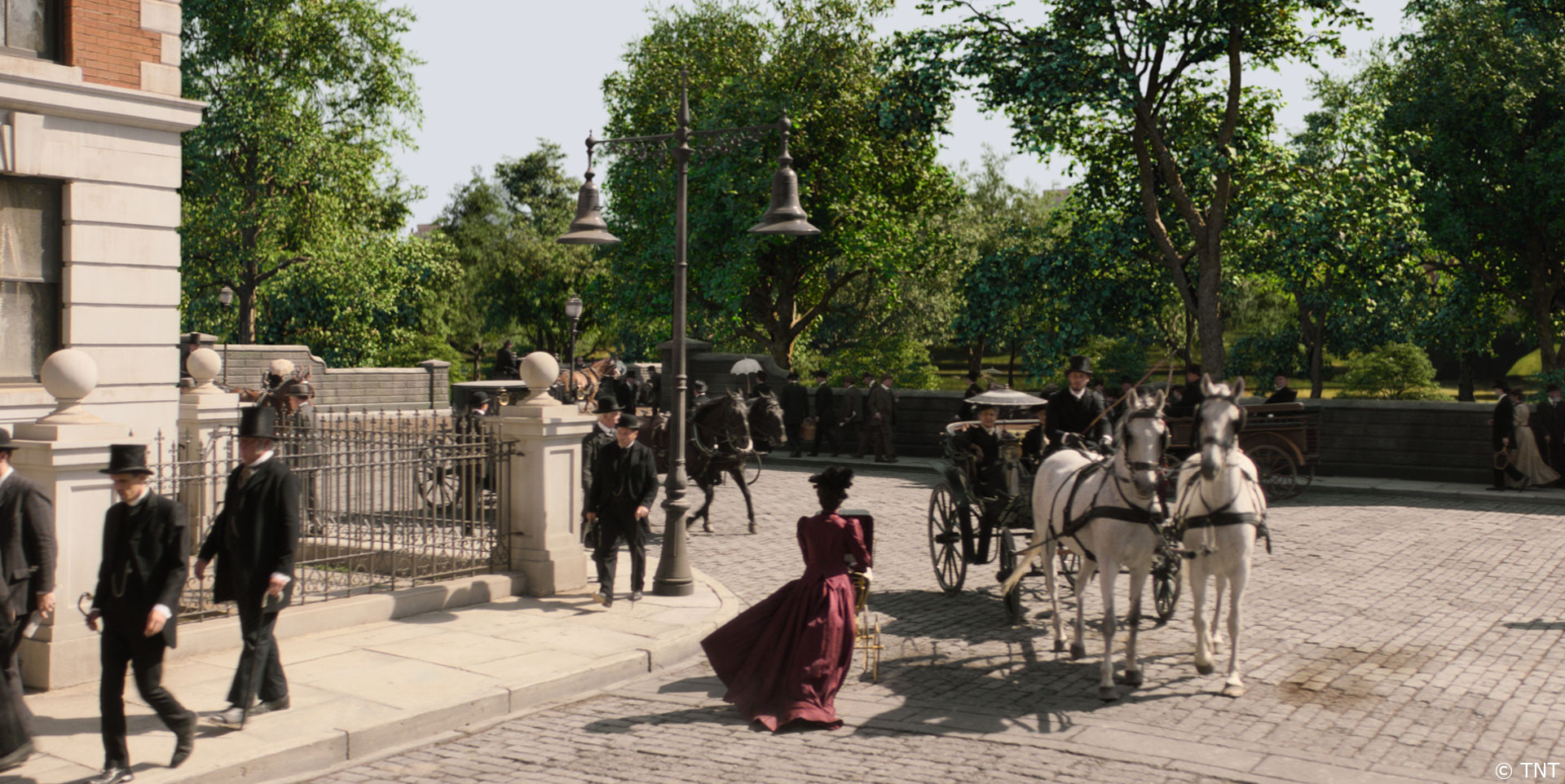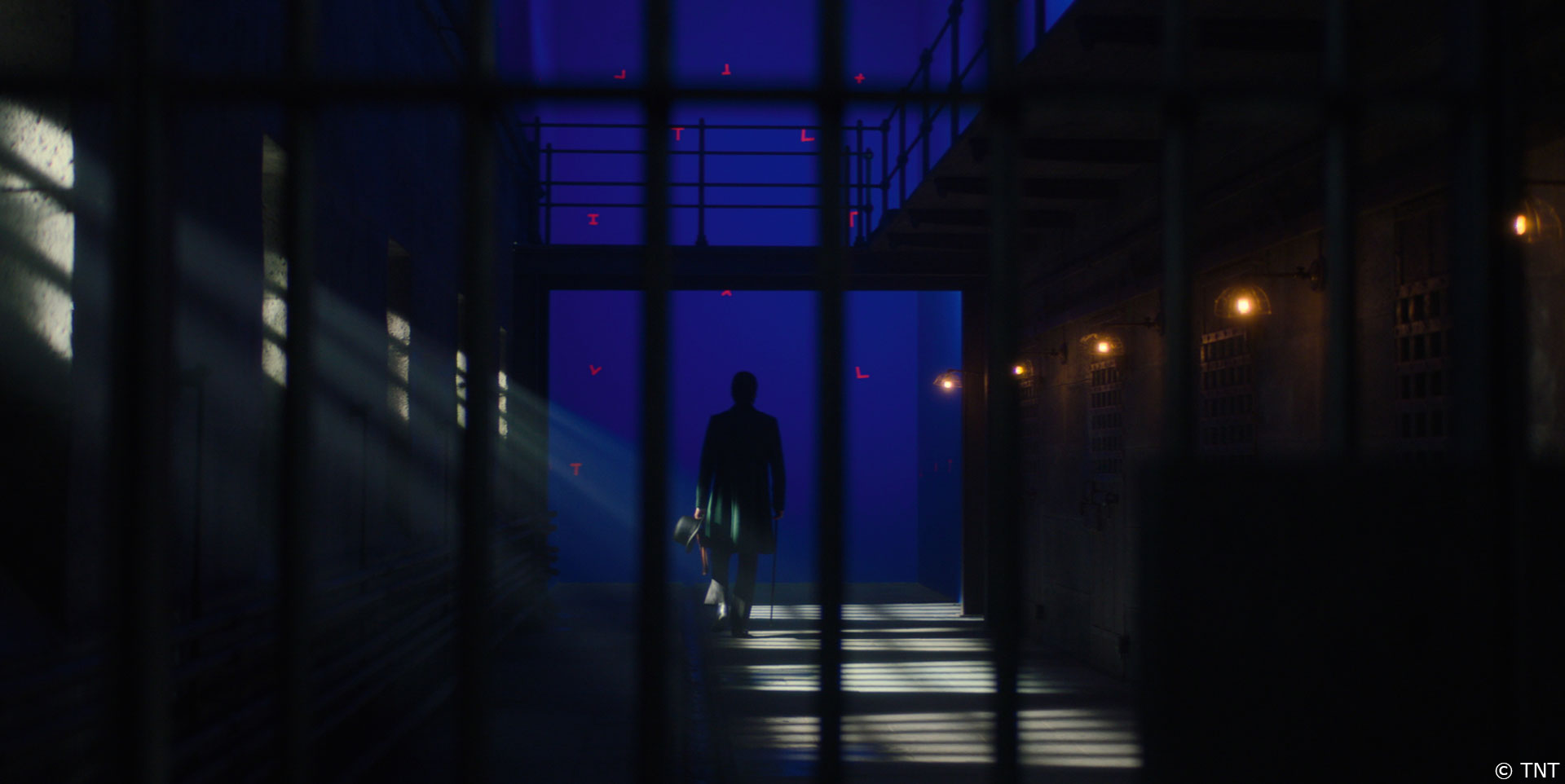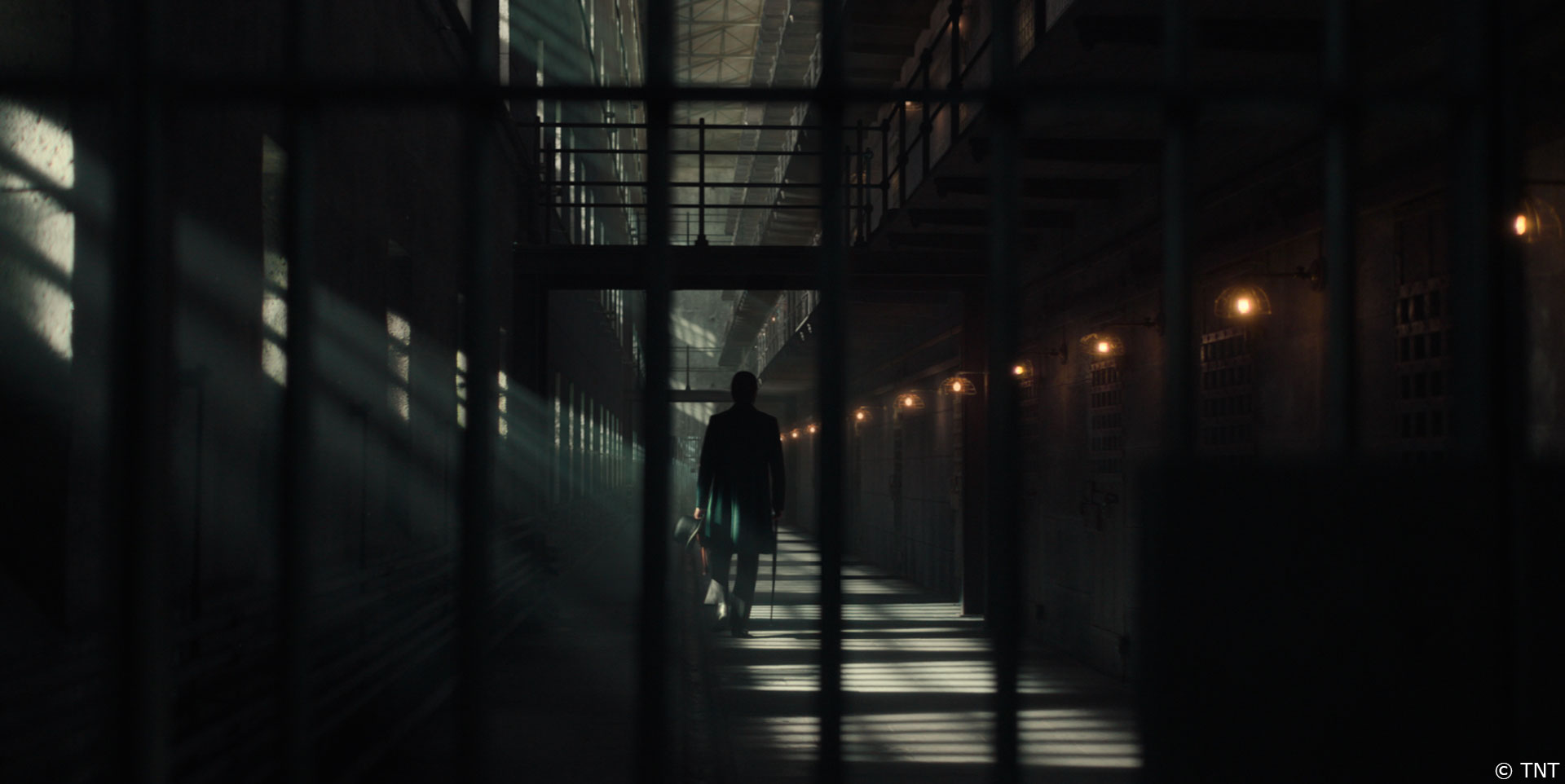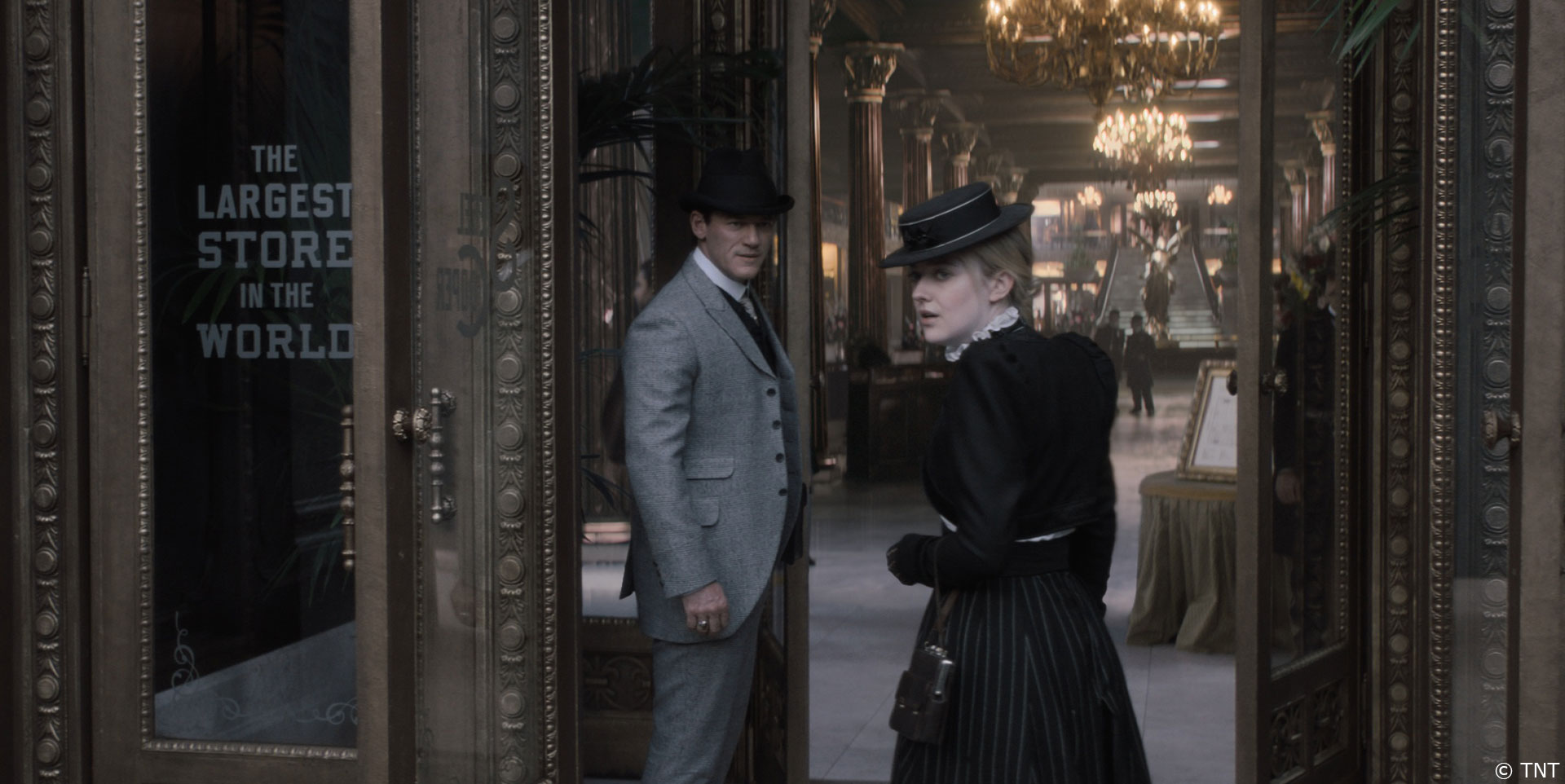Doug Larmour began his career in visual effects in 1999 at MPC. He has also worked at Weta Digital and One of Us. He has worked on a number of films including PROMETHEUS, GUARDIANS OF THE GALAXY, THE JUNGLE BOOK and VENOM.
What is your background?
I trained as a compositor while working at MPC back in the late 90’s. Gradually working up the ranks at MPC I became a 2D supe and small budget film VFX supe before taking a short stint at Weta to work on KING KONG. After that I returned to 2D suping at MPC and then taking on the Global head of 2D role for MPC, helping to set up the comp teams in Canada and India. A couple of years a go I left MPC to be a VFX supe at One of Us and recently took the chance to be overall VFX supervisor on THE ALIENIST: ANGEL OF DARKNESS. This is my first overall VFX supervisor role.
How did you get involved on this show?
I worked on the first season of THE ALIENIST in 2018 while as a VFX supe for One of Us. That show went very well and it meant that I had a good working relationship with Ben Rosenblatt who was the Exec producer on the first season. In late 2019 I rang up Ben to see what was going on with him and he mentioned that they were about to start prep on the second season and very happily he asked if I’d like to be the VFX supe. It was very good timing.
How was the collaboration with the Showrunner Stuart Carolan and the various directors?
I have to say it was an absolute pleasure working with Stuart, David Caffrey (Director), Clare Kilner (Director), and the whole creative team on the series. It was an incredibly open and collaborative process. Everyone was as keen to make the show as stunning visually as it could have been. The scripts were very fluid until a couple of weeks before shooting which meant that we were able to hone the exact shots that we expected to shoot and plan accordingly, whilst also pitching our own take on how it might look, or where to put in a big establisher, and where also we could save expense by keeping things more tight. Cathal Watters (the DOP) was especially helpful in this regard.
What was their expectations and approach about the visual effects?
The expectations of the VFX on ANGEL OF DARKNESS were fairly high. The first series won an Emmy for the VFX and so the production were keen to continue setting an extremely high bar. Having said that, although the scope of work was fairly large, it was quite traditional in style and approach.
For the main part the VFX were there to add scale to New York, either by creating big full CG establishers to the changes of location in the story or by extending the view from the backlot set or locations. With it being a second season, there was already a good understanding of what would need to happen in regards to bluescreens at the end of sets, while the first season acted as a benchmark to what the series needed to look like and the art department were keen to do a lot of concept work to sell their own vision too. There was very little need for previsualisations, except for the biggest CG shots, and with the stories not fully set until shortly before shooting, and the use of an already built huge backlot of New York streets, there was little need for anything like LED back projections. And so for the main part, during prep and shoot the role was to ensure everyone in the creative team was happy with what we would see down each street, signing off on concept work for this, and picking the right moment for any big establisher; making sure that the plates were shot for these establishers during principal photography. Gladly, only early assembly edits had begun before the end of principal photography and so the on set VFX team could concentrate on this before switching gears to delivery. Obviously during post, the expectations raised further as we were aiming for as photo real product as possible.
How did you organize the work with your VFX Producer?
Rather unusually we had 2 VFX producers on the show, Jessica Smith acted as the VFX producer for the on set and early edit portion of the show in Budapest and London, while Mike Silver acted as the VFX producer for the back end of post and delivery from LA. Bizarre at this seems, this worked quite well.
While in prep Jessica and I sifted through the scripts, breaking down where we thought there would be VFX needed. I did the creative breakdown whilst Jessica dealt with the vendors and sifted the early numbers. We then both discussed this with the executive production team, directors and DoP’s as to how many and what type of shots this would get us for the budget that we had. We decided on exact shots and then during photography made sure that we were on hand to keep to as much of this plan as we could. As there was often 2 or more units running Jessica and I had help from Csaba Toth (the Hungarian assistant VFX supervisor) to be on hand at all times to advise on what we needed. Jessica would also keep a track of what had been shot to make sure we hadn’t missed anything during the very hectic shoot schedule. Jessica would also be checking in with the editors at regular intervals, to see if anything would need to be reshot as the story developed. Then, when the first 2 blocks had finished (and while we were shooting the second 2 blocks) we started kicking off the vendors in Montreal as to what we needed from them from a temp screening point of view and organizing their delivery schedule. From this point Mike took control of the turnover process and became a point of contact for the vendors in the same time zone.
Once principal was finished the focus and hub of the production moved from Budapest to London. The entire edit team plus David Caffrey, Stuart Carolan, Ben Rosenblatt, Kari Hobson (co-producer) Jessica and I all moved to London to start post production in earnest. Here the story really started to form and the VFX changed from possible shots to actual shots. Jessica, Mike and I would all be on daily remote vendor reviews, whilst Jessica and I were on hand to advise the creatives on the implications of story changes or new full cg shots. Jessica also started handing over more of the vendor chats to Mike. By Christmas, 2 months after principal had wrapped and with the edit almost complete, Mike took over the VFX producer role in full. At this point Ben Rosenblatt and Kari Hobson moved back to LA where Mike was already based while I remained in London and Jessica left the show. In this final section of post, I looked after the creative and technical look of the shots remotely, whilst Mike tracked cost, schedule and delivery date and was on hand to Ben and Kari to advise and chat through any changes to VFX shots in the same time zone.
It sounds like a very complicated set up but it worked very well. What was most interesting is that from a VFX point of view, I was already working remotely from Mike and the vendors even before the Covid-19 situation arose. And so it didn’t really make a difference once everyone had to remote work from home when the pandemic hit. There was obviously a big reshuffle undertaken by Mr. X and Outpost Montreal to move everyone to a remote work set up in Montreal, but from a creative point of view, we were very lucky not to have to change too much.
The series is set in New York at the end of the 19th Century. What was your approach about it?
The show were very keen to be as historically accurate as possible, but also see as much of New York as we possibly could that we would recognize today. The Art dept were also very keen on historical accuracy. They had a researcher on their team who we used on many occasions as well as doing a lot of our own historical research especially into what buildings were around and what ships were being used at the time. In the end we tried to choose angles for our full CG shots which showed off as much as we possibly could so as the audience recognized the city even though it looks completely different today. So obviously, the Brooklyn bridge, Statue of Liberty and Central Park feature heavily, however there is a lot that went into recreating other less well known locations such as the Siegel Cooper Dept Store, Newspaper Row, West Side Piers and Gansevoort Market that should hopefully please the closet historians. They are to the most part as accurately reproduced as possible. We did have to change the order of skyscrapers around Newspaper row to fit the physical location that we shot in, but all the important buildings are still there when you see it in all its glory in Episode 4.
Can you explain in detail about the recreation of New York?
In many ways we were very lucky in that all of the assets from Series 1 had been archived at the end of that show and so we already had some of the building blocks that we needed to recreate New York and we passed these models and textures on to our vendors. However this was only the starting point of what was a very hand made process and didn’t encompass all the builds that we needed for the show. Just as with last season we had to extend the the view at the end of the physical backlot and/or any exterior location, but whereas last season they tended to stay primarily in the lower class areas of New York and only had a few large establishers where New York was seen in the distance, this year we wanted to show off more locations within New York and have grander establishers that got a lot closer to the buildings. And so we first built a 3D building library with several distinct categories. Each category includes between 10 and 20 different buildings for a maximum of variations (lower class, upper class, industrial area, piers, etc…). In order to explore the composition of the shots and the camera movements, we used a geographically accurate representation of the whole city as a base. With hundreds of simple cubes and volumes that represent a rough scale of volumes. Once we were satisfied with a movement and a framing per shot, we placed each building by hand up to a distance beyond which we could no longer perceive parallax.
Of particular note were 2 parts of New York; first of all there was Central Park and secondly, an area around City hall called Newspaper Row, where the earliest Skyscrapers in New York were built to house the increasingly powerful Newspaper Barons such as William Randolph Hearst and where most of our story revolves.
Outpost were tasked with creating a full CG Central Park that had to seem to be right next to a house on the backlot which we were using as the Spanish Consulate. There was little in regards to a mid ground between this building and the park and the shots with this view of Central Park had to cut seamlessly with shots that were filmed in a real park in Budapest, so the bar was very high in regards to photo-reality of the trees if we were not to notice the jump. What is more we had to see this park from several different angles in day and at night, and so the only way was to build this in CG. To their credit James Rustad and his team jumped at this with vigor and spent the next few months building around 17 different types of tree in Speedtree which we placed individually along with bushes and DMP distant views to create a seamless view of one of New Yorks most recognizable landmarks.
Mr. X were tasked with the slightly more challenging job of recreating the high views of Manhattan island and a few of the larger set pieces in the show such as The Siegel Cooper building, West Side piers, Gansevoort Market and in particular a full CG Newspaper Row that we fly through in Episode 4. Whenever we see Manhattan island from a distance or height we can always see Newspaper row as it is the focal point of the story that entwines the show. For this reason we had to build very high resolution versions of the buildings that encompass this square such as the New York Journal, The World building, City Hall and the train station that stood at the New York end of Brooklyn Bridge. The fly through in episode 4 was actually a fairly late addition to the shot roster and so it is to their acclaim that they were able to repurpose the city build that they had used for the wides of new york to acheive this shot which flies right next to the most iconic buildings in the city at that time.
What was your main source of references?
As I mentioned before, the Art Department were very keen to keep everything they did as historically accurate as possible. Ruth Ammon, the production designer, and her researcher Natasha Pearl had collated a vast collection of period photographs that showed what the city looked like in 1897. We used that and our own building specific internet research to guide the vendors in their design of the buildings that they filled New York with Mr. X and Outpost were also constantly coming back with their own reference images from the New York archives website which we discussed a lot.
How did you recreate the various carriage, boats and trains?
Luckily this is another area where we inherited some useful assets from season 1. The few exceptions for this were the recreation of a New York trolley car, the RMS Campania and an update to last season’s train. In this series we see Sara taking a tram/trolley car for the first time, and so we had a moveable prop on set for this that we had to recreate later and so we took some very detailed scanning and photographic reference on set that helped us recreate it later in Maya.
The bigger challenge however was the recreation of an ocean liner based on the RMS Campania that we see mostly in Episode 2 docked at West Side piers and steaming up the Hudson at various points in the show. For this we used a lot of photographic reference and used that to modify a model that Mr. X had made. We messed about with the model for that a few times until we had something which we felt worked.
Finally, you will see a train popping up more than once in our version of New York. Mr.X took last years model and updated it to be seen from every angle and a lot closer. It was a hero asset for them.
Did you use procedural tools for the recreation of the city?
To be honest, no. Most of the buildings and trees were hand placed for flexibility. Some of the blocks were of course reused and a large portion of South Manhattan is reused in several shots. But most of the layouts are handmade and customized according to the needs of the shot with special attention to the foreground.
How did you populate the streets?
We shot several hours worth of carriage run and crowd walking elements with 3 cameras from different angles and then also with generic rising and falling camera moves that were the basis of a lot of the mid ground crowd replication, with the far BG populated with CG people for the bigger scenes. However there was a large amount of background actors that were beautifully costumed and so a lot of the closer shots didn’t need much augmentation at all.
Can you tell us more about the Hudson river creation?
For the most part we tried to keep the water as simple as possible. Most of the time that you see the Hudson it its a simple Houdini water surface sim as opposed to a dynamic water simulation. We created 3 different degrees of water agitation. Slight adjustments were made from one shot to the next then any boat wake was a separate generic sim that was composited on top.
The city is seen in various lighting conditions. How did you handle this aspect?
There are loads of street extensions throughout the show in different lighting conditions, so for the most part we couldn’t just use a DMP where we might have wanted to, instead every extension had to be a CG build. As mentioned above, we inherited a lot of CG assets from series 1, which included lots of different types of house and street furniture too, like street lamps, street stalls, fire hydrants and signs etc. This meant that it wasn’t as monumental a task as it sounds. However most sets that we built digitally had to be able to be lit both during the day and at night and so we had to do a look dev process for both times of day and sometimes sunset too. As is usual with this process we would pick out a key shot from each environment in each lighting set up and try to work these up first. Once we had approval for these particular key shots we would then be able to roll the look out across the sequences. I think the main 808 Broadway extension is the only environment that you see at all times of day, but this being the main environment where Sara is set it means that we had to nail the look of the street in both directions and Mr. X spent a good while perfecting how this looked. What is more, we see this environment in the last shot of the series where we tried to change the light throughout the shot to try and make it seem as if the shot was being filmed just as the clouds broke, bathing Broadway and New York with a new light to signify a new beginning. So we didn’t make it easy for ourselves.
Which location in New York was the most complicate to create and why?
There are several environments that were very complicated to build. Newspaper row had a massive amount of CG detail needed; Westside piers had a lot of water and CG boats, Central Park needed very photo real trees, but Newspaper Row is probably the most complicated, it needed very high detail on multiple buildings; it needed crowd, boats, water, traffic, a large DMP, was meant to be at the last moment of Sunset and so it needed a very bespoke lighting set up. It had atmospherics and birds. It had everything, but I think Damien Hurgon and the entire Mr. X team did a marvelous job. Its one of the standout shots of the series.
Where were the various parts of the series filmed?
The entire show was filmed in Budapest. We were based at Stern Studios just outside of Budapest. Here we built a lot of the interior sets such as 808 broadway, Spanish Consulate, Libby’s house, but there were also interior sets built at other locations throughout the city. The backlot at Origo studios was our other main venue. Here, the production had built around 6 full scale streets of 19th Century New York for Series 1. This was completely revamped and updated for Series 2 and once more this became our main exterior location, with several streets doubling up for different locations. Half way through the shoot Ruth Ammon and her amazing Art Dept, completely destroyed what had been over 100 metres of Hudson street and recreated Brooklyn in a week. It was a crazy build schedule, but they pulled it off.
We also shot at several exterior locations in and around Budapest. The Citadella, the main fort that sits on Gallert hill overlooking Budapest, doubled as the exterior to Sing Sing Prison which made for a stunning if hot days shooting; whilst Liberty Square became our Newspaper Row.
How did you choose the various VFX vendors?
As with most VFX these days, tax incentives play a fairly large part in choosing which VFX facility to use. For this production it was decided that it made sense to mainly use vendors in Montreal. We put out tenders to a number of the main facilities in Montreal, but in the end we decided to go with Mr. X and Outpost who were both fairly new to the Montreal scene. We couldn’t have been happier with our choices. Both of the facilities went the extra mile to make the show as good as it could have been.
On a different note, we were able to keep some of the VFX in Europe. We had a small in house team in London and we also did some work in Budapest. One of our Hungarian Post production crew recommended a small local facility in Budapest called Front VFX. I cannot praise them enough. They weren’t of a large enough scale to take on the bigger pieces of the show, but what ever we gave them they did with excellence.
How did you split the work amongst these vendors?
For the most part this came down to trying to keep individual locations and therefore individual environments with one vendor. This worked well and meant that there wasn’t too much need for sharing assets and redoing work between vendors. There were a few exceptions to this. Both main facilities worked on different aspects of the exterior of Sing sing, newspaper Row and the Spanish Consulate, but where collaboration was needed it worked extremely well.
Can you tell us more about your collaboration with their VFX supervisors?
I have to admit that both Damien Hurgon at Mr. X and James Rustad at Outpost did a fantastic job and the show is a testament to them and their team’s skill. For practicality reasons, neither Damien nor James were able to be with us on set, but this allowed them to concentrate on planning and designing their teams work. At the start of the show we kicked both teams off with the work that they would be doing on the show. From day one we were able to share as much of the original concept images that the art dept and I had found that best illustrated the look we were going for and we were able to give them the on set data that we had collected for the purpose of creating the extensions. But from this point onwards it was their teams who brought this to life, presenting enhanced concepts and post vis to nail down the looks of each extension and doing this early enough that we were able to make key changes and get studio approval for the feel of each environment.
Although I am much more of a fan of being able to sit around a table with those that I am collaborating with, the distance between our shoot and post locations in Europe and the VFX team in Montreal made this impossible, but the editorial teams made light of this distance and with almost daily calls or cineSync chats it soon became easy to discuss matters in massive amounts of detail. Little did we know that setting up the teams in this way from the start would actually weirdly benefit us later when the Covid Pandemic hit as we were already set up for working remotely.
Which sequence or shot was the most challenging?
The shot which proved trickiest is probably the exterior approach to Sing Sing prison that we see towards the start of Episode 1. Environmental VFX always works best when you have as much physically real set to play with in your foreground so you instantly believe the reality of the background as long as you match the camera move and shapes and texture detail of that foreground. However with this shot we never had much of a foreground to speak of. It was a fairly late decision within the shoot schedule that we needed to have an approach shot to Sing Sing prison from fairly far away from the prison itself. By this time we didn’t have access to the Citadella (which had doubled as the prison exterior earlier in the shoot) and so we had to make do with a carriage running towards a section of bluescreen that we had built on our backlot. This meant that we had to put CG environment in the FG as well as the BG which led to many hours of look development on every part of the shot. In the end we were happy with the shot, but it took a lot of effort from the entire team to get it there.
Did you want to reveal any other invisible effects?
What many people won’t realize is that we had to digitally change some costumes in the series. During the editing process, it made sense for the story to take a couple of different scenes that were shot in the same location with the same actors, but were meant to be on different story days and mush them together to make it appear as they were one scene shot on the same day. The major sticking point to this was that the characters would be wearing different costumes on those different story days. So in order to make this work, we had to recreate costumes digitally and cover up the old costumes for some of these scenes. Both Front and Outpost rose to this very tricky task changing the colour and cut of waistcoats, jackets and ties while the characters moved all over the place. It made for some very tricky tracking tasks. Basically we had to make super accurate digital doubles with difficult flowing cloth sims.
Is there something specific that gives you some really short nights?
Not really, I never thought we wouldn’t get where we needed to. It was a pleasure to work on the show
What is your favourite shot or sequence?
My favourite shot has to be the sweeping shot past Newspaper Row. Its big and beautiful and full of detail
What is your best memory on this show?
My best memory is probably the first day of shooting on set. With some tinkering still going on with the script and the principal actors still rehearsing the finer points of it, it was decided that we would shoot the plates for one of our biggest shots: the pan down onto the Siegel Cooper building. We had a big scorpio crane, about 16 carriages, 100 extras and a crew eager to get going. It felt great that VFX was at the centre of that rather than taking up the last 5 minutes of the day.
How long have you worked on this show?
From March 2019 till July 2020 – so 1 year 4 months – quite a while
What’s the VFX shots count?
883.
What was the size of your team?
On set we had 6 in production, 9 riggers, 4 in house artists, a VFX editor and then the teams at Mr. X, Outpost and Front which in total was between 60 and 100
What is your next project?
Nothing planned as yet.
What are the four movies that gave you the passion for cinema?
STAR WARS, JAWS, TOP GUN and anything by Alfred Hitchcock.
I have no idea what that says about me.
A big thanks for your time.
WANT TO KNOW MORE?
Outpost VFX: Dedicated page about THE ALIENIST – ANGEL OF DARKNESS on Outpost VFX website.
© Vincent Frei – The Art of VFX – 2020


